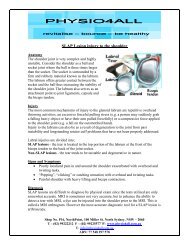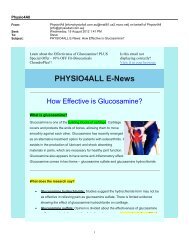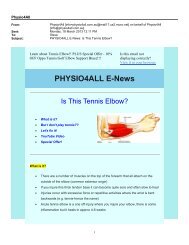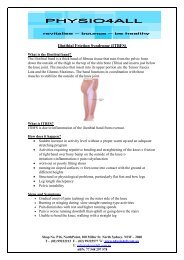The Prevent injury and Enhance Performance Program - PHYSIO4All
The Prevent injury and Enhance Performance Program - PHYSIO4All
The Prevent injury and Enhance Performance Program - PHYSIO4All
Create successful ePaper yourself
Turn your PDF publications into a flip-book with our unique Google optimized e-Paper software.
PHYSIO4ALL<br />
revitalise – bounce – be healthy<br />
<strong>The</strong> PEP <strong>Program</strong>: <strong>Prevent</strong> <strong>injury</strong> <strong>and</strong> <strong>Enhance</strong> <strong>Performance</strong><br />
This prevention program consists of a warm-up, stretching, strengthening, plyometrics,<br />
<strong>and</strong> sports specific agilities to address potential deficits in the strength <strong>and</strong> coordination of the<br />
stabilizing muscles around the knee joint. It is important to use proper technique during all of the<br />
exercises. <strong>The</strong> coaches <strong>and</strong> trainers need to emphasize correct posture, straight up <strong>and</strong> down jumps<br />
without excessive side-to-side movement, <strong>and</strong> reinforce soft l<strong>and</strong>ings. This program should be<br />
completed 3 times a week.<br />
If you are using this program with athletes that are twelve or under, please perform the<br />
plyometrics over a visual line on the field or a flat 2” cone <strong>and</strong> l<strong>and</strong> each jump with two feet. Do not<br />
perform single leg plyometrics with young individuals until they demonstrate substantial control (see<br />
addendum).<br />
Section I: Warm–up<br />
Warming up <strong>and</strong> cooling down are a critical part of a training program. <strong>The</strong> purpose of the warm-up<br />
section is to allow the athlete to prepare for activity. By warming up your muscles first, you greatly<br />
reduce the risk of <strong>injury</strong>.<br />
A. Jog Line to line (cone to cone): ElapsedTime:0--0.5 minutes<br />
Purpose: Allows the athletes to slowly prepare themselves for the training<br />
session while minimizing the risk for <strong>injury</strong>. Educate athletes on good running<br />
technique; keep the hip/ knee/ ankle in a straight alignment without the knee<br />
caving in or the feet whipping out to the side.<br />
Instruction: Complete a slow jog from near to far side line.<br />
B. Shuttle Run (side to side) Elapsed Time:0.5 to 1 minute<br />
Purpose: engage hip muscles (inner <strong>and</strong> outer thigh). This exercise will<br />
promote increased speed. Discourage inward caving of the knee joint.<br />
Instruction: Start is an athletic stance with a slight bend at the knee. Leading<br />
with the right foot, side step pushing off with the left foot (back leg).When<br />
you drive off with the back leg, be sure the hip/ knee/ ankle are in a straight<br />
line. Switch sides at half field.<br />
C. Backward Running Elapsed Time: 1–1.5 minutes<br />
Purpose: continued warm-‐up; engage hip extensors/ hamstrings. Make sure<br />
the athlete l<strong>and</strong>s on her toes. Be sure to watch for locking of the knee joint. As<br />
the athlete brings her foot back, make sure she maintains a slight bend to the<br />
knee.<br />
Instruction: Run backwards from side line to side line. L<strong>and</strong> on your toes<br />
without snapping the knee back. Stay on your toes <strong>and</strong> keep the knees slightly<br />
bent at all times.<br />
Shop No. P16, NorthPoint, 100 Miller St. North Sydney. NSW – 2060<br />
T – (02) 99222212 F – (02) 99225577 W: www.physio4all.com.au E: info@physio4all.com.au<br />
ABN: 77 548 297 578
PHYSIO4ALL<br />
revitalise – bounce – be healthy<br />
D. St<strong>and</strong>ing Hip Swings (Forwards/Backwards)<br />
Purpose: Dynamic stretch of Hamstings/Hip Flexors<br />
Instruction: St<strong>and</strong>ing with partner support slowly swinging leg forward<br />
then backward with a slowly increasing arc up to full range. Complete 15<br />
reps gradually increasing speed to simulate a kick. Important to maintain<br />
tall body posture <strong>and</strong> to stay relaxed.<br />
E. St<strong>and</strong>ing Hip Swings (Outside/Inside)<br />
Purpose: Dynamic stretch of Groin/ Gluteals<br />
Instruction: St<strong>and</strong>ing with partner support slowly swinging leg sideways<br />
in <strong>and</strong> out slowly increasing arc up to full range. Complete 15 reps<br />
gradually increasing speed to simulate a strong pass. Again important to<br />
maintain tall body posture <strong>and</strong> to stay relaxed.<br />
Section II: Strengthening –<br />
This portion of the program focuses on increasing leg strength. This will lead to increased leg strength<br />
<strong>and</strong> a more stable knee joint. Technique is everything; close attention must be paid to the performance of<br />
these exercises in order To avoid <strong>injury</strong>.<br />
A. Walking Lunges (1 minute) ElapsedTime:1.5–2.5min<br />
Purpose: Strengthen the thigh (quadriceps) muscle.<br />
Instruction: Lunge forward leading with your right leg. Push off<br />
with your right leg <strong>and</strong> lunge forward with your left leg. Drop the<br />
back knee straight down. Make sure that your keep your front knee<br />
over your ankle. Control the motion <strong>and</strong> try to avoid you front knee<br />
from caving inward. If you can’t see your toes on your leading leg,<br />
you are doing the exercise incorrectly.<br />
B. Russian Hamstring (1minute) ElapsedTime:2.5–3.5min<br />
Purpose: Strengthen hamstrings muscles<br />
Instruction: Kneel on the ground with h<strong>and</strong>s at your side. Have a<br />
partner hold firmly at your ankles. With a straight back, lead forward<br />
leading with your hips. Your knee, hip <strong>and</strong> shoulder should be in a<br />
straight line as you lean toward the ground. Do not bend at the waist.<br />
You should feel the hamstrings in the back of your thigh working.<br />
Repeat the exercise for 30 seconds <strong>and</strong> switch with your partner.<br />
Shop No. P16, NorthPoint, 100 Miller St. North Sydney. NSW – 2060<br />
T – (02) 99222212 F – (02) 99225577 W: www.physio4all.com.au E: info@physio4all.com.au<br />
ABN: 77 548 297 578
PHYSIO4ALL<br />
revitalise – bounce – be healthy<br />
C. Single Toe Raises (1minute) ElapsedTime:3.5–4.5min<br />
Purpose: This exercise strengthens the calf muscle <strong>and</strong> increases balance.<br />
Instruction: St<strong>and</strong> up with your arms at your side. Bend the left knee up<br />
<strong>and</strong> maintain your balance. Slowly rise up on your right toes with good<br />
balance. You may hold your arms out ahead of you in order to help.<br />
Slowly repeat 30 times <strong>and</strong> switch to the other side. As you get stronger,<br />
you may need to add additional repetitions to this exercise to continue the<br />
strengthening effect of the exercise.<br />
Section III: Plyometrics –<br />
<strong>The</strong>se exercises are explosive <strong>and</strong> help to build, power, strength <strong>and</strong> speed. <strong>The</strong> most important element<br />
when considering performance technique is the l<strong>and</strong>ing. It must be soft! When you l<strong>and</strong> from a jump,<br />
you want to softly accept your weight on the balls of your feet slowly rolling back to the heel with a bent<br />
knee <strong>and</strong> a bent hip. <strong>The</strong>se exercises are basic, however, it is critical to perform them correctly. Please<br />
begin these exercise using a flat cone (2 inches) or with a visual line on the field.<br />
A. Lateral Hops over Cone (30 seconds) Elapsed Time: 4.5–5 min<br />
Purpose: Increase power/ strength emphasizing neuromuscular control<br />
Instruction: St<strong>and</strong> with a 2” cone to your left. Hop to the left over the<br />
cone softly l<strong>and</strong>ing on the balls of your feet l<strong>and</strong> bending at the knee.<br />
Repeat this exercise hopping to the right. Progress to single leg hops.<br />
B. Forward/ Backward Hops over cone (30 sec) Elapsed Time: 5-5.5 min<br />
Purpose: Increase power/ strength emphasizing neuromuscular<br />
control<br />
Instruction: Hop over the cone softly l<strong>and</strong>ing on the balls of your<br />
feet <strong>and</strong> bending at the knee. Now, hop backwards over the ball<br />
using the same l<strong>and</strong>ing technique. Be careful not to snap your<br />
knee back to straighten it. You want to maintain a slight bend to<br />
the knee.<br />
C. Single Leg hops over cone (30 seconds) Elapsed Time: 5.5–6 min<br />
Purpose: Increase power/ strength emphasizing neuromuscular control.<br />
Instruction: Hop over the cone l<strong>and</strong>ing on the ball of your<br />
foot bending at the knee. Now, hop backwards over the cone<br />
using the same l<strong>and</strong>ing technique. Be careful not to snap<br />
your knee back to straighten it. You want to maintain a<br />
slight bend to the knee. Now, st<strong>and</strong> on the left leg <strong>and</strong> repeat<br />
the exercise. Increase the number of repetitions as needed.<br />
Shop No. P16, NorthPoint, 100 Miller St. North Sydney. NSW – 2060<br />
T – (02) 99222212 F – (02) 99225577 W: www.physio4all.com.au E: info@physio4all.com.au<br />
ABN: 77 548 297 578
PHYSIO4ALL<br />
revitalise – bounce – be healthy<br />
D. Vertical Jumps with headers (30 seconds) Elapsed Time: 6–6.5<br />
min<br />
Purpose: Increase height of vertical jump.<br />
Instruction: St<strong>and</strong> forward with h<strong>and</strong>s at your side. Slightly bend the knees<br />
<strong>and</strong> push off jumping straight up. Remember the proper l<strong>and</strong>ing technique;<br />
accept the weight on the ball of your foot with a slight bend to the knee.<br />
E. Scissors Jump (30 seconds) Elapsed Time: 6.5-7 min<br />
Purpose: Increase power <strong>and</strong> strength of vertical jump.<br />
Instruction: Lunge forward leading with your right. Keep your knee<br />
over your ankle. Now, push off with your right foot <strong>and</strong> propel your left<br />
leg forward in to a lunge position. Be sure your knee does not cave in or<br />
out. It should be stable <strong>and</strong> directly over the ankle. Remember the<br />
proper l<strong>and</strong>ing technique; accept the weight on the ball of your foot<br />
with a slight bend to the knee. Repeat 20 times.<br />
Section IV: Agilities<br />
A. Forward run with 3 step deceleration Elapsed Time: 7–8 min<br />
Purpose: Increase dynamic stability of the ankle/ knee/ hip complex.<br />
Instruction: Starting at the first cone, sprint forward to the second<br />
cone. As you approach the cone, use a 3 step quick stop to decelerate.<br />
Continue onto cone 2 using the same strategy to decelerate. Do not let<br />
your knee extend over your toe. Do not let you’re your knee cave<br />
inward. This exercise is used to teach the athlete how to properly<br />
accelerate <strong>and</strong> decelerate while moving forward.<br />
B. Lateral Diagonal runs (3 passes) Elapsed Time: 8–9 min<br />
Purpose: To encourage proper technique/ stabilization of the knee. This<br />
exercise will also deter a “knock knee” position from occurring–which<br />
is a dangerous position for the ACL. Instruction: Face forward <strong>and</strong><br />
laterally run to the first cone on the right. Pivot off the right foot <strong>and</strong><br />
shuttle run to the second cone. Now pivot off the left leg <strong>and</strong> continue<br />
on to the third cone. Make sure that the outside leg does not cave in.<br />
Keep a slight bend to the knee <strong>and</strong> hip <strong>and</strong> make sure the knee stays<br />
over the ankle joint.<br />
C. Bounding run (44 yds) Elapsed Time: 9-10 min<br />
Purpose: To increase hip flexion strength/ increase power/ speed<br />
Instruction: Starting on the near sideline, run to the far side with knees<br />
up toward chest. Bring your knees up high. L<strong>and</strong> on the ball of your<br />
foot with a slight bend at the knee <strong>and</strong> a straight hip. Increase the<br />
distance as this exercise gets easier.<br />
Shop No. P16, NorthPoint, 100 Miller St. North Sydney. NSW – 2060<br />
T – (02) 99222212 F – (02) 99225577 W: www.physio4all.com.au E: info@physio4all.com.au<br />
ABN: 77 548 297 578
PHYSIO4ALL<br />
revitalise – bounce – be healthy<br />
Begin your training session with your coach. After the completion of<br />
training, resume the PEP program at section V.<br />
Section V: Stretching –<br />
It is important to incorporate a short warm-up prior to stretching. Never stretch a “cold muscle”. By<br />
performing these stretches, you can improve <strong>and</strong> maintain your range of motion, reduce stiffness in your<br />
joints, reduce post-exercise soreness, reduce the risk of <strong>injury</strong> <strong>and</strong> improve your overall mobility <strong>and</strong><br />
performance. Note: This portion of the program may be moved to the end of your training session. Do a<br />
warm-up such as brisk walking for 5 to 10 minutes before stretching. Gently stretch to a point of tension<br />
<strong>and</strong> hold. Hold the stretch for 30 seconds. Concentrate on lengthening the muscles you are stretching.<br />
Breathe normally.<br />
A. Calf stretch (30 seconds x 2 reps) Elapsed Time: 10 to 11 minutes<br />
Purpose: stretch the calf muscle of the lower leg<br />
Instruction: St<strong>and</strong> leading with your right leg. Bend forward at the<br />
waist <strong>and</strong> place your h<strong>and</strong>s on the ground (V formation). Keep your<br />
right knee slightly bent <strong>and</strong> your left leg straight. Make sure your<br />
left foot is flat on the ground. Do not bounce during the stretch.<br />
Hold for 30 seconds. Switch sides <strong>and</strong> repeat.<br />
B. Quadricep stretch (30 seconds x 2 reps) Elapsed Time: 11 to 12 minutes<br />
Purpose: stretch the quadriceps muscle of the front of the thigh<br />
Instruction: Place your left h<strong>and</strong> on your partner’s left shoulder. Reach<br />
back with your right h<strong>and</strong> <strong>and</strong> grab the front of your right ankle. Bring<br />
your heel to buttock. Make sure your knee is pointed down toward the<br />
ground. Keep your right leg close to your left. Don’t allow knee to<br />
wing out to the side <strong>and</strong> do not bend at the waist. Hold for 30 seconds<br />
<strong>and</strong> switch sides.<br />
D. Figure Four Hamstring stretch (30 sec x 2 reps) Elapsed Time: 12–13 min<br />
Purpose: To stretch the hamstring muscles of the back of the thigh.<br />
Instruction: Sit on the ground with your right leg extended out in<br />
front of you. Bend your left knee <strong>and</strong> rest the bottom of your foot<br />
on your right inner thigh. With a straight back, try to bring your<br />
chest toward your knee. Do not round your back. If you can, reach<br />
down toward your toes <strong>and</strong> pull them up toward your head. Do not<br />
bounce. Hold for 30 seconds <strong>and</strong> repeat with the other leg.<br />
Shop No. P16, NorthPoint, 100 Miller St. North Sydney. NSW – 2060<br />
T – (02) 99222212 F – (02) 99225577 W: www.physio4all.com.au E: info@physio4all.com.au<br />
ABN: 77 548 297 578
PHYSIO4ALL<br />
revitalise – bounce – be healthy<br />
D. Inner Thigh Stretch (20sec x 3reps) Elapsed Time: 13-14min<br />
Purpose: Elongate the muscles of the inner thigh (adductor<br />
group)<br />
Instruction: Remain seated on the ground. Spread you legs<br />
evenly apart. Slowly lower yourself to the center with a straight<br />
back. You want to feel a stretch in the inner thigh. Now reach<br />
toward the right with the right arm. Bring your left arm overhead<br />
the stretch over to the right. Hold the stretch <strong>and</strong> repeat on the<br />
opposite side.<br />
E. Hip Flexor Stretch (30sec x 2reps) Elapsed Time: 14--‐15min<br />
Purpose: Elongate the hip flexors of the front of the thigh.<br />
Instruction: Lunge forward leading with your right leg.<br />
Drop your left knee down to the ground. Placing your<br />
h<strong>and</strong>s on top of your right thigh, lean forward with your<br />
hips. <strong>The</strong> hips should be square with your shoulders. If<br />
possible, maintain your balance <strong>and</strong> lift back for the left<br />
ankle <strong>and</strong> pull your heel to your buttocks. Hold For 30<br />
Seconds <strong>and</strong> repeat on the other side.<br />
Alternative Exercises- Warm Down <strong>and</strong> Cool Down –<br />
We all know how imperative a cool down is. Please don’t skip it. It allows the muscles that have been<br />
working hard throughout the training session to elongate <strong>and</strong> deters the onset of muscle soreness. Please<br />
emphasize the importance of adequate fluid intake (optimally water). <strong>The</strong> cool down should take<br />
approximately 10 minutes. It should begin with a slow jog to allow the heart rate to come down before<br />
stretching. This should be followed by some light strength training exercises. In addition to those basic<br />
stretches, we are offering some additional stretches to target 3 muscle groups that are often forgotten.<br />
A. Bridging with Alternating Hip Flexion (1 minute)<br />
Purpose: Strengthen outer hip muscles (Hip abductors, flexors) <strong>and</strong><br />
buttocks<br />
Instruction: Lie on the ground with your knees bent with feet on the<br />
ground. Raise your buttocks up off the ground <strong>and</strong> squeeze. Now,<br />
lift your right foot off the ground <strong>and</strong> make sure that your right hip<br />
does not dip down. Lower your right foot <strong>and</strong> now lift your left foot<br />
making sure your left hip does not dip down. Repeat 30 times on<br />
each side. As you get stronger, you will place your feet on top of a<br />
ball <strong>and</strong> repeat the exercise.<br />
Shop No. P16, NorthPoint, 100 Miller St. North Sydney. NSW – 2060<br />
T – (02) 99222212 F – (02) 99225577 W: www.physio4all.com.au E: info@physio4all.com.au<br />
ABN: 77 548 297 578
PHYSIO4ALL<br />
revitalise – bounce – be healthy<br />
B. Abdominal Crunches (1 minute)<br />
Purpose: Strengthen the abdominals (rectus abdominus, obliques)<br />
Instruction: Lie on the ground with your knees bent. Place your h<strong>and</strong>s behind<br />
your head with your elbows out wide. Support your neck lightly with your<br />
fingers. Take a deep breath in <strong>and</strong> slowly contract your abdominal muscles as<br />
you exhale. Repeat 30 times. Drop your legs off to the right side. Slowly<br />
crunch up with your elbows out wide. You should feel your oblique muscles<br />
working on the side of your waist. Repeat 30 times <strong>and</strong> switch to the other side.<br />
C. Single <strong>and</strong> Double Knee to Chest (supine) (30 seconds x 2 reps)<br />
Purpose: Elongate the low back muscles<br />
Instruction: Lie on your back. Bring your right knee toward your chest <strong>and</strong><br />
hug firmly. Keep your left leg out straight in front of you. You should feel a<br />
stretch along your low back <strong>and</strong> into your buttocks. Hold the stretch for 30<br />
seconds <strong>and</strong> switch sides. Now bring both knees to chest. If you feel any<br />
pain in the low back, discontinue the stretch <strong>and</strong> inform your coach/trainer.<br />
D. Figure Four Piriformis stretch- supine (1 minute)<br />
Purpose: Elongate the rotators of the hip.<br />
Instruction: Lie on your back <strong>and</strong> bend both of your knees. Fold your left<br />
ankle over your right knee. Place your h<strong>and</strong>s behind your right thigh <strong>and</strong> pull<br />
your right knee to chest. You should feel a good stretch in the left gluteals<br />
region <strong>and</strong> the side of the thigh. Hold for 30 seconds <strong>and</strong> repeat on the other<br />
side. If you experience <strong>and</strong> low back pain with this stretch, slowly lower your<br />
legs down <strong>and</strong> let your coach/trainer know.<br />
E. Seated Butterfly stretch - seated (30 sec x 2 reps)<br />
Purpose: Elongate the inner thigh muscles (adductors).<br />
Instruction: Sit up bringing your feet in so that the soles of your feet are<br />
touching. Gently place your elbows on your knees <strong>and</strong> slowly push<br />
down. You should feel a good stretch of the inner thigh. Hold this for 30<br />
seconds <strong>and</strong> repeat 2 to 3 times.<br />
Shop No. P16, NorthPoint, 100 Miller St. North Sydney. NSW – 2060<br />
T – (02) 99222212 F – (02) 99225577 W: www.physio4all.com.au E: info@physio4all.com.au<br />
ABN: 77 548 297 578
PHYSIO4ALL<br />
revitalise – bounce – be healthy<br />
ADDENDUM for Younger Athletes (Under 12)<br />
This program is safe to use for male <strong>and</strong> female athletes over the age of 12. You can safely utilize this<br />
program with younger athletes by making the modifications described below:<br />
With the plyometric activities, have your younger athletes jump over a visual line on the field (midfield,<br />
end line, or sideline) or a flat 2” cone. <strong>The</strong> emphasis of this activity is the l<strong>and</strong>ing technique – not the<br />
height of the object that the athlete is jumping over.<br />
In addition, the younger athletes should perform the plyometric activities with a two-legged l<strong>and</strong>ing.<br />
Again, the emphasis is on the l<strong>and</strong>ing <strong>and</strong> knee control (not allowing the knees to cave inward <strong>and</strong><br />
bending the knees <strong>and</strong> the hips to accept the force of l<strong>and</strong>ing).<br />
Repetitions are not emphasized in this program – time is. We would prefer to see 5 repetitions with<br />
perfect biomechanical technique completed in the allotted time period as opposed to doing ten<br />
repetitions haphazardly.<br />
This program should be completed at the BEGINNING of the practice session. If you attempt to use<br />
this program after your training session, your athletes will be fatigued <strong>and</strong> their biomechanical technique<br />
will suffer. <strong>The</strong> element of fatigue can put your athletes at a higher risk for <strong>injury</strong>.<br />
For implementation of the PEP, a similar set up has been used by using the following<br />
link which you might find useful;<br />
www.youtube.com/watch?v=t_yz7yWLo5o<br />
Reference: <strong>The</strong> Santa Monica Sports Medicine Research Foundation<br />
Shop No. P16, NorthPoint, 100 Miller St. North Sydney. NSW – 2060<br />
T – (02) 99222212 F – (02) 99225577 W: www.physio4all.com.au E: info@physio4all.com.au<br />
ABN: 77 548 297 578
PHYSIO4ALL<br />
revitalise – bounce – be healthy<br />
SET UP<br />
<strong>The</strong> field should be setup 10 minutes prior to the warm-up. This will allow for a smooth transition between the activities. A sample field set-up is<br />
shown in the diagram below. This program should take approximately 15-20 minutes to complete. However, when you first begin the program, it may<br />
take slightly longer due to the fact that you must first become well acquainted with the program <strong>and</strong> the transitions. Alongside each exercise you will<br />
notice a box with the approximate amount of time that should be spent on each activity. This will serve as a guide line to you in order to conduct your<br />
warm-up in a time efficient manner.<br />
Shop No. P16, NorthPoint, 100 Miller St. North Sydney. NSW – 2060<br />
T – (02) 99222212 F – (02) 99225577 W: www.physio4all.com.au E: info@physio4all.com.au<br />
ABN: 77 548 297 578










